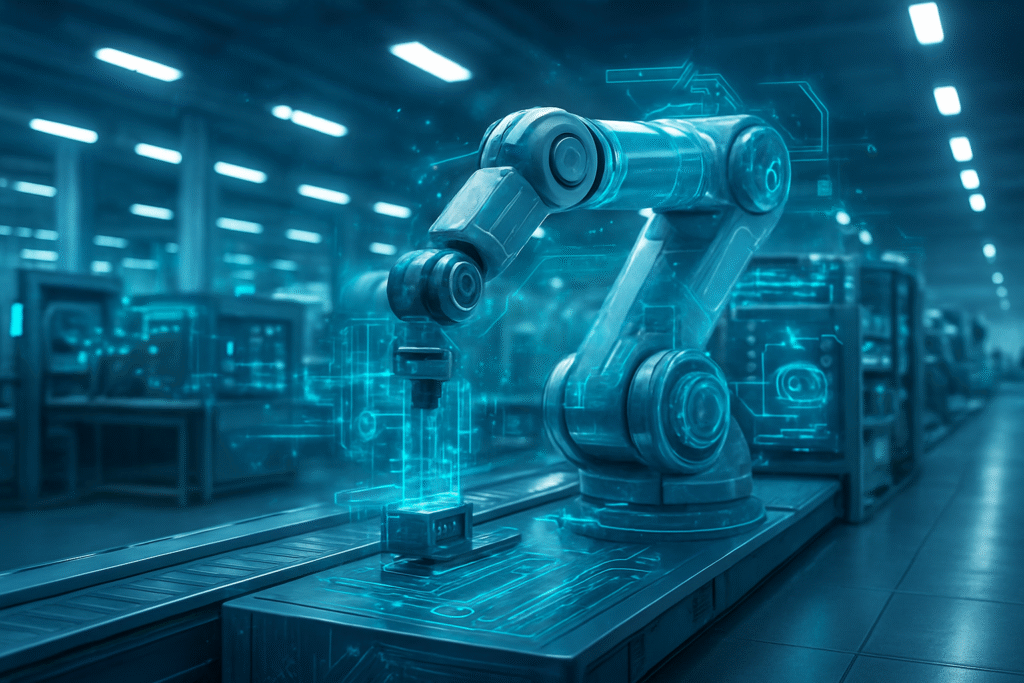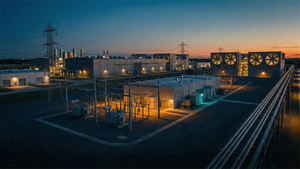
In a significant stride for industrial automation and smart factory initiatives, STMicroelectronics (NYSE: STM) today, November 6, 2025, announced the launch of its groundbreaking ISM6HG256X dual-range motion sensor. This innovative three-in-one MEMS inertial sensor, integrating advanced edge AI capabilities, is poised to redefine data acquisition and processing in demanding industrial environments, promising unprecedented levels of efficiency, safety, and intelligence. The announcement marks a pivotal moment in the ongoing evolution of Industry 4.0 and the emerging Industry 5.0 paradigm, where intelligent sensors are the bedrock of autonomous and adaptive industrial processes.
The introduction of the ISM6HG256X comes on the heels of other strategic advancements by STMicroelectronics, including the definitive agreement in July 2025 to acquire NXP's MEMS sensors business for $950 million, a move expected to significantly bolster ST's capabilities in high-performance sensors. Coupled with the recent launch of a new family of 5MP CMOS image sensors (VD1943, VB1943, VD5943, and VB5943) in October 2025, STMicroelectronics is cementing its position at the forefront of the smart sensor revolution. These developments collectively underscore a clear industry trend towards highly integrated, intelligent, and robust sensing solutions that process data at the edge, reducing latency and reliance on cloud infrastructure.
Technical Prowess: Consolidating Intelligence at the Edge
The ISM6HG256X stands out with its ability to simultaneously sense dual-range acceleration – a sensitive ±16g for detecting subtle motions and a robust ±256g for capturing extreme impacts – alongside an integrated high-performance gyroscope. This unique combination in a compact 2.5mm x 3mm package eliminates the need for multiple discrete sensors, drastically simplifying system design, reducing the bill-of-materials, and lowering overall power consumption. Its embedded Machine Learning Core (MLC) and Finite State Machine (FSM) are central to its "edge AI" capabilities, enabling real-time event detection and context-adaptive sensing directly within the sensor. This on-chip processing capability significantly reduces the data bandwidth required for transmission and offloads computational burden from main processors, leading to enhanced power efficiency and faster decision-making.
This approach represents a significant departure from previous generations of industrial sensors, which typically required external microcontrollers or cloud-based processing for complex data analysis. By embedding intelligence at the sensor level, STMicroelectronics' new offerings, including other MLC-integrated IMUs like the ISM330DHCX and LSM6DSOX, facilitate a shift from reactive to proactive industrial operations. The 5MP CMOS image sensors further complement this intelligence, offering unique hybrid global and rolling shutter modes, advanced 3D stacking, and on-chip HDR for high-speed, high-detail machine vision, crucial for precision robotics and quality control in automated manufacturing. Initial reactions from the AI research community and industry experts describe the ISM6HG256X as "game-changing," "setting a new benchmark" for its integration and efficiency, and providing "more than 50% current reduction" compared to some competitors.
Competitive Landscape and Market Implications
STMicroelectronics (NYSE: STM) is poised to significantly benefit from these advancements, solidifying its market leadership in MEMS sensors for industrial applications. The ISM6HG256X and the broader portfolio of intelligent sensors offer a compelling value proposition, enabling customers to develop more compact, power-efficient, and intelligent industrial IoT devices. The strategic acquisition of NXP's MEMS sensors business is particularly impactful, broadening ST's intellectual property and product offerings, especially in high-performance safety-critical sensors, which have direct applicability in industrial vehicles and heavy machinery. This move strengthens ST's competitive edge against major players like Bosch Sensortec and Texas Instruments (NASDAQ: TXN), both of whom are also heavily investing in AI-integrated smart sensor platforms.
The competitive implications for major AI labs and tech companies are substantial. As sensors become more intelligent and capable of local data processing, the demand for cloud-based AI inference might shift, although cloud platforms will remain crucial for large-scale data aggregation, model training, and complex analytics. This development could disrupt existing product lines that rely on less integrated, less intelligent sensor architectures, forcing competitors to accelerate their own edge AI sensor development. For startups, these highly integrated components could lower the barrier to entry for developing sophisticated industrial IoT solutions, as they can leverage advanced sensing and processing capabilities without extensive in-house hardware design. STMicroelectronics' commitment to a 10-year longevity for many of its industrial sensors also provides a strategic advantage, offering long-term supply assurance critical for industrial customers.
Wider Significance: Fueling the Smart Factory Revolution
These advancements by STMicroelectronics fit perfectly into the broader AI landscape and the accelerating trend towards pervasive intelligence, particularly at the edge. The smart sensor market, projected to grow from USD 49.6 billion in 2025 to USD 187.2 billion by 2032, underscores the critical role these components play in the digital transformation of industries. By embedding Machine Learning Cores and Intelligent Sensor Processing Units, STMicroelectronics is not just providing data; it's enabling real-time, context-aware insights that are fundamental to Industry 4.0's vision of connected, self-optimizing factories and Industry 5.0's focus on human-centric, sustainable, and resilient industrial processes.
The impacts are far-reaching. Enhanced efficiency translates to reduced operational costs and increased productivity through optimized resource utilization and automated processes. Predictive maintenance, powered by real-time anomaly detection and vibration analysis (e.g., using sensors like the IIS3DWB), dramatically reduces unplanned downtime and extends equipment lifespan. Safety is significantly improved through applications like worker safety wearables and black box event recording in industrial vehicles, where the ISM6HG256X can capture both subtle and severe impacts. Potential concerns, however, include the complexity of integrating these advanced sensors into legacy systems and ensuring robust cybersecurity for edge AI deployments. Nonetheless, these developments represent a significant leap compared to previous AI milestones, moving beyond mere data collection to intelligent, localized decision-making, which is crucial for truly autonomous industrial systems.
Future Developments and Expert Predictions
Looking ahead, the trajectory for advanced motion sensors in industrial automation is one of increasing integration, higher intelligence, and greater autonomy. Expected near-term developments include further miniaturization of these multi-sensor, edge-AI-enabled packages, allowing for their deployment in an even wider array of industrial assets, from tiny robotic components to large-scale machinery. Long-term, we can anticipate more sophisticated on-chip AI models capable of learning and adapting to specific industrial environments and tasks, potentially leading to fully self-calibrating and self-optimizing sensor networks.
Potential applications on the horizon are vast, encompassing adaptive robotics that can dynamically adjust to changing conditions, advanced asset tracking with granular contextual awareness, and comprehensive digital twins that mirror real-world industrial processes with unprecedented fidelity. Challenges that need to be addressed include the standardization of edge AI frameworks, ensuring interoperability between different sensor ecosystems, and developing robust security protocols to protect sensitive industrial data processed at the edge. Experts predict that the next wave of industrial automation will be characterized by a seamless fusion of physical and digital worlds, driven by these intelligent sensors, leading to more resilient supply chains and hyper-personalized manufacturing. The focus will increasingly shift towards collaborative robotics and human-robot interaction, where precise and intelligent motion sensing will be paramount for safety and efficiency.
A New Benchmark in Industrial Intelligence
In summary, STMicroelectronics' recent advancements, particularly the launch of the ISM6HG256X and the acquisition of NXP's MEMS business, represent a significant inflection point in industrial automation. By embedding sophisticated edge AI capabilities into compact, multi-functional motion sensors, the company is delivering on the promise of the smart factory: enhanced efficiency, proactive predictive maintenance, heightened safety, and overall greater intelligence across industrial environments. These developments not only strengthen STMicroelectronics' market position but also accelerate the broader industry's transition towards more autonomous and adaptive manufacturing processes.
The significance of these intelligent sensors in AI history cannot be overstated; they are the eyes and ears of the industrial AI revolution, enabling real-time insights and localized decision-making that were previously unattainable. As we move forward, the long-term impact will be seen in more sustainable, resilient, and human-centric industrial operations. In the coming weeks and months, the industry will be watching for the widespread adoption of these new sensor technologies, the emergence of innovative applications, and how competitors respond to STMicroelectronics' bold steps in pushing the boundaries of industrial intelligence.
This content is intended for informational purposes only and represents analysis of current AI developments.
TokenRing AI delivers enterprise-grade solutions for multi-agent AI workflow orchestration, AI-powered development tools, and seamless remote collaboration platforms.
For more information, visit https://www.tokenring.ai/.






